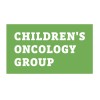Induction Chemotherapy Using Cyclophosphamide and Topotecan in Treating Patients Who Are Undergoing Autologous Peripheral Stem Cell Transplantation for Newly Diagnosed or Progressive Neuroblastoma
Neuroblastoma

About this trial
This is an interventional treatment trial for Neuroblastoma focused on measuring recurrent neuroblastoma, stage 4S neuroblastoma, localized unresectable neuroblastoma, localized resectable neuroblastoma, regional neuroblastoma, disseminated neuroblastoma
Eligibility Criteria
DISEASE CHARACTERISTICS: Histologically or cytologically confirmed neuroblastoma or ganglioneuroblastoma meeting 1 of the following staging criteria: Newly diagnosed disease, at least 1 year of age, and meets criteria for 1 of the following: International Neuroblastoma Staging System (INSS) stage 2a/2b with MYCN amplification (greater than 10) AND unfavorable pathology INSS stage 3 with MYCN amplification OR unfavorable pathology Newly diagnosed INSS stage 4 disease meeting criteria for 1 of the following: Over 18 months of age Age 12 to 18 months with any unfavorable biologic feature (MYCN amplification, unfavorable pathology, and/or DNA index=1) or any biologic feature that is indeterminant, unsatisfactory, or unknown No INSS stage 4 disease and age 12 to 18 months with all 3 favorable biologic features (i.e., nonamplified MYCN, favorable pathology, and DNA index greater than 1) Newly diagnosed INSS stage 3, 4, or 4S disease AND under 1 year of age with MYCN amplification At least 1 year of age and initially diagnosed with INSS stage 1, 2, or 4S disease that progressed to stage 4 without interval chemotherapy Must have been enrolled on COG-ANBL00B1 at initial diagnosis PATIENT CHARACTERISTICS: Age 30 and under at initial diagnosis Performance status Not specified Life expectancy Not specified Hematopoietic Absolute neutrophil count at least 1,000/mm^3* Platelet count at least 100,000/mm^3* (transfusion independent) Hemoglobin at least 10.0 g/dL* (red blood cell transfusions allowed) NOTE: *Granulocytopenia, anemia, and/or thrombocytopenia allowed for patients with tumor metastatic to the bone marrow Hepatic Bilirubin no greater than 1.5 mg/dL ALT less than 300 IU/L Renal Creatinine no greater than 1.5 mg/dL Creatinine clearance or radioisotope glomerular filtration rate at least 60 mL/min Cardiovascular ECG normal Shortening fraction at least 27% by echocardiogram OR Ejection fraction at least 50% by MUGA Other Not pregnant or nursing Negative pregnancy test Fertile patients must use effective contraception HIV negative PRIOR CONCURRENT THERAPY: Biologic therapy Not specified Chemotherapy See Disease Characteristics No more than 1 prior chemotherapy course on the low- or intermediate-risk neuroblastoma studies (COG-P9641, COG-A3961) prior to determination of MYCN amplification and Shimada histology Endocrine therapy Not specified Radiotherapy Prior localized emergency radiotherapy to sites of life-threatening or function-threatening disease allowed Surgery Not specified Other No other prior systemic therapy
Sites / Locations
- UCSF Comprehensive Cancer Center
- Children's Memorial Hospital - Chicago
- St. Jude Children's Research Hospital
- Children's Hospital and Regional Medical Center - Seattle
- Mary Bridge Children's Hospital and Health Center - Tacoma
- Westmead Hospital
Arms of the Study
Arm 1
Experimental
All patients
Induction Cycles 1 and 2 (CT) (21 days each), Cyclophosphamide (Days 1 thru 5) weight based dosage (> 12 kg 400 mg/m2/day, < 12 kg 13.3 mg/kg/day, < 2 years old N/A. Topotecan (Days 1 thru 5) weight based dosage (> 12 kg 1.2 mg/m2/day, < 12 kg 0.04 mg/kg/day, < 2 years old 0.04 mg/kg/day). Filgrastim (Days 6 →) weight based dosage (> 12 kg 5 micrograms/kg, < 12 kg 5 micrograms /kg, < 2 years old 5 micrograms /kg.
Outcomes
Primary Outcome Measures
Secondary Outcome Measures
Full Information
1. Study Identification
2. Study Status
3. Sponsor/Collaborators
4. Oversight
5. Study Description
6. Conditions and Keywords
7. Study Design
8. Arms, Groups, and Interventions
10. Eligibility
12. IPD Sharing Statement
Learn more about this trial
